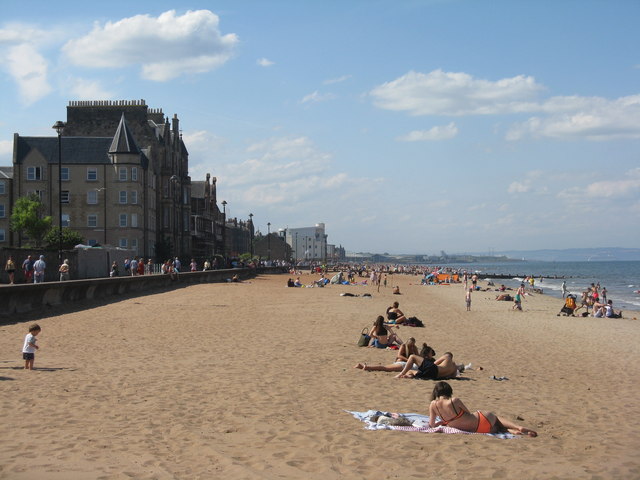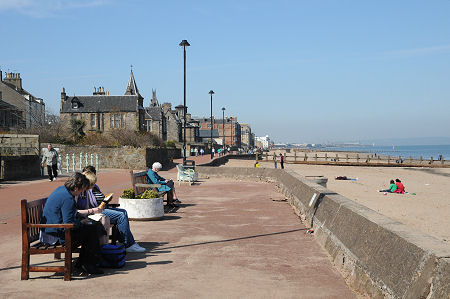Portobello - Edinburgh
Portobello - Edinburgh
Το Portobello είναι ένα παραθαλάσσιο προάστιο του Εδιμβούργου. Βρίσκεται στην ανατολική κεντρική Σκωτία, 5 μίλια ανατολικά του κέντρου της πόλης του Εδιμβούργου, με θέα το Firth of Forth, μεταξύ των προαστίων Joppa και Craigentinny. Παρόλο που ιστορικά ήταν μια πόλη από μόνη της, είναι επίσημα ένα οικιστικό προάστιο του Εδιμβούργου.
Portobello




History
The area was originally known as Figgate Muir, an expanse of moorland through which the Figgate Burn flowed as the Braid Burn continuation to the sea, with a broad sandy beach on the Firth of Forth. The name Figgate was thought to come from the Saxonterm for "cow's ditch". The land was used as pasture for cattle by the monks of Holyrood Abbey and the name is more likely to mean "cow road" as in Cowgate in Edinburgh.[1] In 1296, William Wallace mustered forces on the moor in a campaign that led to the Battle of Dunbar, and in 1650 it was the supposed scene of a secret meeting between Oliver Cromwell and Scottish leaders. A report from 1661 describes a race in which twelve browster-wives ran from the Burn (recorded as the Thicket Burn) to the top of Arthur's Seat.[2]
By the 18th century, it had become a haunt of seamen and smugglers. A cottage was built in 1742 on what is now the High Street (close to the junction with what is now Brighton Place) by a seaman called George Hamilton, who had served under Admiral Edward Vernon during the 1739 capture of Porto Bello, Panama, meaning literally "beautiful port or harbour", and who named the cottage Portobello Hut in honour of that victory. By 1753, there were other houses around it. The cottage itself remained intact until 1851, becoming a hostelry for travellers known as the Shepherd's Ha'.[2]
In 1763, the lands known as the Figgate Whins were sold by Lord Milton to Baron Mure for about £1,500, and afterwards feued out by the latter to William Jameson or Jamieson at the rate of £3 per acre.[3] Jameson discovered a valuable bed of clay near the burn, and built a brick and tile works beside the stream. He later built an earthenware pottery factory, and the local population grew so that Portobello became a thriving village.[2] Land values subsequently rose, and by the beginning of the 19th century some parts had been sold at a yearly feu-duty of £40 per annum per acre.[4]
Portobello Sands were used at that time by the Edinburgh Light Horse for drill practice. Walter Scott was their quartermaster, and in 1802 while riding in a charge he was kicked by a horse and confined to his lodgings for three days. While recovering, he finished The Lay of the Last Minstrel.[2] The Scots Magazine in 1806 noted that the lands were "a perfect waste covered almost entirely with whins or furze". Portobello developed into a fashionable bathing resort, and in 1807 new salt-water baths at the foot of Bath Street and Regent Street were erected at a cost of £5,000.[4][3] In 1822, the visit of King George IV to Scotland, organised by Scott, included a review of troops and Highlanders held on the sands, with spectators crowding the sand dunes.[2]
During the 19th century, Portobello became an industrial town, manufacturing bricks (the "Portobello brick"), glass, lead, paper, pottery, soap, and mustard. Joppa to the east was important in the production of salt.
In 1833, the town was made a burgh, then in 1896 it was incorporated into Edinburgh by Act of Parliament.[5] A formidable red-brick power station (designed by Ebenezer James MacRae) was built in 1934 at the west end of the beach and operated until 1977. It was demolished in the following 18 months.[6]
Between 1846 and 1964, a railway station provided ready access for visitors to the resort, whose facilities came to include a large open-air heated swimming pool, where the actor Sean Connery once worked as a lifeguard. It made use of the power station's waste heat. The pool was closed in 1979. There was also a lido (now demolished) and a permanent funfair which closed in 2007. In 1901, Portobello Baths were opened on The Promenade overlooking the beach. The baths, now known as Portobello Swim Centre, are now home to one of only three remaining operational Turkish baths in Scotland still open to the public.[7]
Portobello Pier was a pleasure pier situated near the end of Bath Street. It operated from 23 May 1871 until the start of World War I. The pier was 1,250 feet (381 m) long and had a restaurant and observatory at the end. It cost £7,000 to build and was designed by Sir Thomas Bouch, who was infamously linked to the Tay Bridge disaster. The iron supports rusted away and the pier was demolished as uneconomic to repair in 1917.
The Edinburgh Marine Gardens were built north of Kings Road in 1908–9. They included an open-air theatre, an industrial hall, a ballroom (later used as a skating rink), a scenic railway, a "rustic mill and water-wheel" and a speedway track. It fell out of use in World War I and never recovered. The speedway/motor cycle track remained in operation until 1939 and the outbreak of World War II. The site was cleared in 1966 and taken over for the Lothian Buses Marine bus depot.
Portobello Town Hall fell into redundancy when Portobello was placed under the jurisdiction of Edinburgh and the building was converted into a cinema in 1912 by Robert Lorimer and Robert Matthew.[8] On the demise of cinemas in the 1970s the building returned to council ownership and was renamed as Portobello Town Hall again. It is a venue for functions but despite its name has no town–hall function.
The Portobello Lido was built in 1933. Extended police and media attention to the July 1983 abduction of five year-old Caroline Hogg from the Promenade area and her murder by Robert Black had a strong impact on the area.[9]
Portobello's peak as a resort was in the late 19th century, and it was in slow decline throughout the 20th century. Whilst visitors were primarily drawn from the inhabitants of Edinburgh,[10] it was also once popular with Glaswegians, particularly when the Glasgow Fair"trade holiday" signalled the start of a two-week holiday for the west of Scotland.[11] By the 1960s, it had become an area of amusement arcades and a number of permanent funfair attractions. From the 1980s onwards, these gradually disappeared, and by the end of the 20th century the Promenade had almost no attractions specific to its seaside location (although the Tower Amusements arcade remains in business).
The 21st century has seen the emergence of many community organisations, some specifically focused on the Promenade. The beach hosts regular beach volleyball, including hosting the Olympic beach volleyball qualifiers,[12] as well as hosting one of Europe's biggest busking events, the annual Big Beach Busk.[13] Other community organisations are more focused on the sea. These include the "Portobello, Sailing, Kayaking and Rowing Club",[14] Rowporty [15] and Eastern Amateur Coastal Rowing Club.[16] Others have focused on developing community gardens [17] and a monthly local food market [18], while others have focused on youth theatre [19] and culture and music.[20].
Scottish Environment Protection Agency (SEPA) classified the quality of the swimming water as "poor" (Portobello West) and "sufficient" (Portobello Central) in its 2017 and 2018 surveys.[21] Despite this, sightings of dolphins off the coast in 2018 suggests water quality had improved.[22] A wild swimmers' club that has been braving the waves throughout the year since 2010,[23] also suggests this, meanwhile a warmer alternative is provided by the Turkish Baths [24] in Portobello Swim Centre.
In October 2016, Portobello became the first urban community in Scotland to register a Community Right to Buy after the 2016 expansion of Land reform in Scotland to cover urban areas.[25] Purchase of Bellfield Old Parish Church and Halls by Action Porty for £600,000 was confirmed by Scottish Government Ministers on 3 May 2017, a purchase partly funded by the Scottish Land Fund and partly by community donations and borrowing.[26] The buildings and grounds were formally passed from the Church of Scotland to Action Porty on 6th September 2017 and opened to the community as Bellfield (Community Centre), Portobello on 23 June 2018.[27]

Σχόλια
Δημοσίευση σχολίου